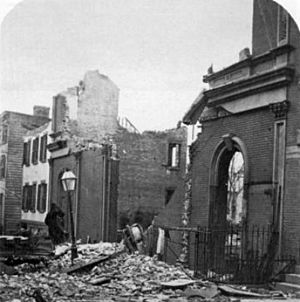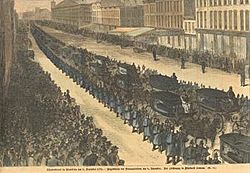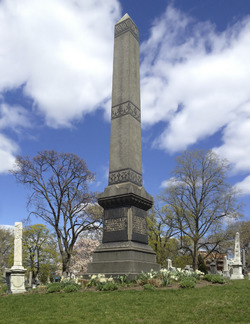Brooklyn Theatre fire facts for kids

Brooklyn Theatre from Johnson Street, shortly after December 5, 1876, fire
|
|
| Date | December 5, 1876 |
|---|---|
| Time | About 23:20 local time |
| Location | the site of what is now 271 Cadman Plaza Brooklyn, NY 11201 United States |
| Casualties | |
| 278–300+ (estimated range) | |
The Brooklyn Theatre fire was a catastrophic theatre fire that broke out on the evening of December 5, 1876, in the city of Brooklyn (now a borough of New York City). The fire took place at the Brooklyn Theatre, near the corner of Washington and Johnson streets, with over a thousand guests attending. The conflagration killed at least 278 individuals, with some accounts reporting more than 300 dead. 103 unidentified victims were interred in a common grave at Green-Wood Cemetery, marked by an obelisk, while more than two dozen identified victims were interred individually in separate sections at the Cemetery of the Evergreens in Brooklyn.
The Brooklyn Theatre fire ranks third in fatalities among fires occurring in theatres and other public assembly buildings in the United States, falling behind the 1942 Cocoanut Grove fire and the 1903 Iroquois Theatre fire.
Fatalities mainly arose in the family circle, the highest tier in the theatre offering the cheapest seats. This gallery sustained extreme temperatures and dense, suffocating smoke early in the conflagration. Only one stairway served it which became jammed with people and cut off escape for more than half the gallery's occupants.
Fire

On Tuesday evening, December 5, 1876, about a thousand patrons were in attendance. Samuel Hastings, who collected tickets at the gallery entrance, estimated that there were about 400 people in the family circle. One of the theatre owners, Col. Abner Keeny, said that about 360 people purchased tickets for the dress circle and about 250 people in the parquet and parquet circle. Edward B. Dickinson, a patron in the middle of the parquet about five rows from the stage, thought the auditorium floor was not more than half full. Charles Vine, high in the family circle, thought it was "one of the biggest galleries" he had seen in a long time.
The play proceeded without incident until 11 p.m., the intermission between the fourth and fifth act. The drop curtain was down, hiding the stage, and the orchestra was playing. Some attendees in the parquet circle heard what sounded like a brawl behind the curtain, shouting and machinery working, noise carrying above the orchestra's playing.
Behind the curtain, actors were taking their positions in a box set of an old boathouse on the bank of the Seine. Made of painted canvas on a flimsy wooden frame, the curtain blocked the backstage from view. Kate Claxton, playing Louise the blind orphan girl, along with actors J. B. Studley and H. S. Murdoch, had taken their places on stage and were waiting for the curtain to rise. Claxton was lying on a pallet of straw, looking up. Actors Mary Ann Farren and Claude Burroughs were waiting in the wings.
Actors' attempt to extinguish the fire and quell panic
Kate Claxton, H. S. Murdoch, and J. B. Studley at first urged the audience to be seated and "to be calm, as calmness was self possession, and self possession security". Thomas Rocheford, head usher, went to the auditorium when he heard someone yell 'Fire!' He later testified: "Mr. Studley and Mr. Murdoch sung out to the people to keep their seats. I also stopped quite a number going out who were making a rush. Finally a good many of them cooled down and took their seats."
From his vantage point in the family circle, Charles Vine thought that Claxton was "the nerviest woman I ever saw ... [She] came out with J. B. Studley, and said the fire would be out in a few moments. She was white as a sheet, but she stood up full of nerve."
The Brooklyn Daily Eagle reported Claxton saying, "There is no danger; the flames are a part of the play." The assertion was disingenuous – fire had no part in the story – and it would soon prove short-lived. "As she spoke," the Eagle continued, "a burning piece of wood fell at her feet, and she uttered an involuntary exclamation of alarm. This broke the spell which had heretofore held the audience."
Panic erupted. Thought turned to quelling it. J. B. Studley in particular reasoned: "If I have the presence of mind to stand here between you and the fire, which is right behind me, you ought to have the presence of mind to go out quietly." Kate Claxton echoed J. B. Studley's line, and stage manager J. W. Thorpe appeared, also urging an orderly exit. But the audience was now thoroughly panicked and ignored those on the stage.
Claxton later recalled, "We were now almost surrounded by flames; it was madness to delay longer. I took Mr. Murdoch by the arm and said 'Come, let us go.' He pulled away from me in a dazed sort of way and rushed into his dressing room, where the fire was even then raging ... To leap from the stage into the orchestra in the hope of getting out through the front of the house would only be to add one more to the frantic, struggling mass of human beings who were trampling each other to death like wild beasts."
Claxton remembered that a private passage led from the leading lady's dressing room, through the basement and to the box office. Through that she and fellow actress Maude Harrison bypassed much of the lobby crush. Murdoch and Claude Burroughs thought there was enough time to get their street clothes from their dressing rooms − it was December and their stage costumes were flimsy. They became trapped and did not escape. Some actors and stage hands left by the utility doors exiting onto Johnson Street, but the fire on the stage soon became widespread, cutting those exits off. All the remaining exits were in the front of the house, the main entrance exiting onto Washington street or the special exit doors leading into Flood's Alley.
Theatre evacuation
While the actors were attempting to quell the panic, the head usher, Thomas Rocheford, went to the rear of the auditorium to open the Flood's Alley special exit door on the east end of the vestibule, opposite of the Washington Street entrances, one of the three special exit doors designed by architect Jackson. Since the doors were rarely used, he found the locking mechanism corroded; he was initially unable to open the doors. He found a small piece of metal in his pocket and with this was able to release the doors. This action enabled the people on the floor of the auditorium to evacuate the building fairly quickly, but Rocheford's action came at a cost. The open doors furnished airflow for the fire on the stage, which immediately grew in intensity.
Aftermath
The next foray into the building did not occur until the daylight hours. Chief Nevins had his District Engineers organize recovery parties. Except for a short segment of the vestibule, the building had mainly collapsed into the cellar and burned until the wood was consumed. What first appeared to be a great deal of rubbish in the cellar underneath the vestibule turned out to be largely human remains, a large mass of people which had fallen into twisted and distorted positions and then burned. These were mainly from the gallery and the stairway, which, in the original structure, had been above the vestibule ceiling against the south wall of the building.
Removal of these remains occupied much of the next three days. An exact body count was never obtained, given the state of forensic science in that era. By Friday, December 8, Coroner Simms reported that 293 bodies had been taken from the theatre site. The number was by no means definitive. Later, his own Coroner's Report would cite 283 fatalities. Much later, the memorial stone erected in Green-Wood Cemetery, would reference 278 deaths.
Kate Claxton wrote about the fire nine years later:'
We thought we were acting for the best in continuing the play as we did, with the hope that the fire would be put out without difficulty, or that the audience would leave gradually or quietly. But the result proved that it was not the right course ... The curtain should have been kept down until the flames had been extinguished ... Raising the curtain created a draft which fanned the flames into fury.
—Kate Claxton, The New York Times, November 30, 1885
Kate Claxton's career drastically changed and was closely associated with this incident. It became a pop culture phenomenon to associate any major fire that occurred with her. She disliked this attention, but it did boost her popularity as people were drawn to potential drama ("Kate Claxton, Fire Jinx").
Haverly's Theatre was erected on the same site in 1879, but it was razed 11 years later to make way for new offices of The Brooklyn Daily Eagle. Mid-20th century urban renewal subsumed Washington Street, Flood's Alley, and the site of the fire, giving rise to Cadman Plaza. Cadman Plaza East follows the old Washington Street course but now terminates at Johnson Street. The New York Supreme Court Building is nearest to the site, now occupied by a park on the west side of the courthouse.



